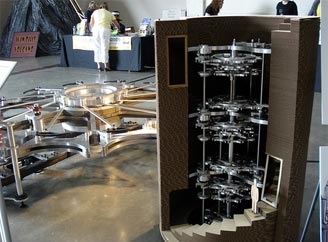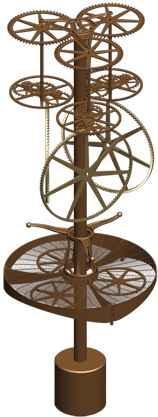Alumnus Designs the Future of Time
-
-
slice.mit.edu
Filed Under
Recommended

As the pioneer behind parallel computers that is the basis for most supercomputers, Danny Hillis '78, SM '81, PhD '88 has certainly helped speed up technology. But for more than 15 years he's been interested in creating what some have called the slowest computer in the world: the 10,000 Year Clock. And after many years of designing and planning, fabrication of the full-size clock parts has begun.
The clock, which will be some 200 feet tall, will reside inside a mountain in West Texas on property owned by Amazon.com founder Jeff Bezos and will run for 10,000 years without electricity. It will tick once a year, the century hand will advance once every 100 years, and the cuckoo will appear on the millennium. In addition, the timepiece's chime generator will create a unique bell-ringing sequence each day. You read that right—the chimes will be programmed to not repeat for 10,000 years.

According to the project website, the clock will be powered by mechanical energy harvested from sunlight as well as visitors (presumably human, though in 10,000 years, who knows?). The primary materials are marine-grade 316 stainless steel, titanium, and dry-running ceramic ball bearings. The inner workings consist of a binary digital-mechanical system (several elements of which have been patented) with 32 bits of accuracy and precision equal to one day in 20,000 years. It self-corrects by "phase-locking" to the noon Sun. The first prototype is on display at the London Science Museum.
Visitors are needed to spur the clock to show the time it knows. Absent human interaction, the clock will use thermal power to keep time, capturing changes in temperature between day and night on the mountain top. This differential power is transmitted to the interior of the clock by long metal rods.
Within the mountain home of the clock will be five large anniversary chambers for the 1, 10, 100, 1,000, and 10,000 year anniversaries. In the one-year chamber will reside a special orrery that in addition to planets and the Earth's moon will show all of the interplanetary probes launched during the 20th century, humankind's first century in space. The clock will activate and run the orrery once a year on a pre-determined date at solar noon. An as-yet-undetermined animation will be created for the 10-year anniversary chamber. If you have an interesting idea, email it to 10-year-chamber@10000yearclock.net. The remaining chambers will be left to the imaginations of future generations.
Hillis, who earned his bachelor's in math and master's and doctorate in electrical engineering and computer science at MIT, also designed the RAID disk array technology used to store large databases. He cofounded Thinking Machines Corp., worked at Walt Disney Imagineering where he designed new theme park rides and a full-sized walking robot dinosaur (among many other accomplishments), and cofounded Applied Minds, where he is currently cochair and CTO. He's also cochair of the Board of Directors of the Long Now Foundation, which was established in 01996 (as the foundation writes its dates) to develop the clock as well as serve as a cultural institution for long-term thinking.
In case you're wondering, the clock should be able to take a licking and keep on ticking. Hillis based his design on several principles, including "expect bad weather, expect earthquakes, expect non-malicious human interaction, and don't tempt thieves." Read the full list.







